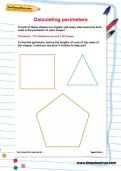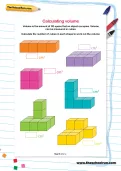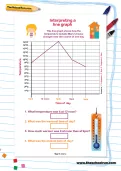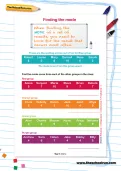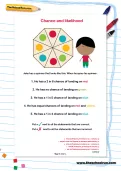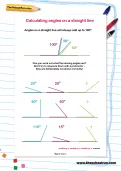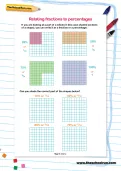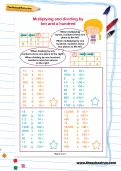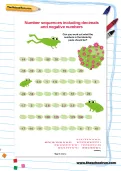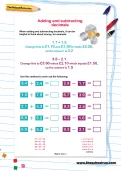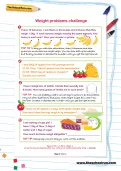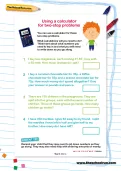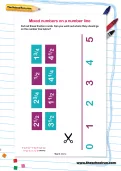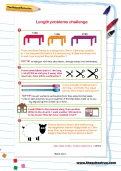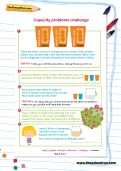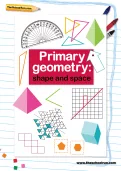This line graph shows how the temperature outside Mary’s house changes over the course of one day. Can you read the graph and answer the following questions?
or
Register to add to your saved resources
Already a subscriber? to view this content.
When finding the MODE of a set of results, you need to look for the result that occurs most often. Find the mode spelling score from each of the groups in this class.
or
Register to add to your saved resources
Already a subscriber? to view this content.
Jake has a spinner that looks like this. Can you work out which of the following statements are correct, thinking about chance and likelihood?
or
Register to add to your saved resources
Already a subscriber? to view this content.
Angles on a straight line will always add up to 180 degrees. Can you work out what the missing angles are? Don’t try to measure them with a protractor – they are deliberately not drawn correctly!
or
Register to add to your saved resources
Already a subscriber? to view this content.
If you are looking at a part of a whole (in this case shaded sections of a shape), you can write it as a fraction or a percentage. Can you shade the correct part of the shapes below?
or
Register to add to your saved resources
Already a subscriber? to view this content.
Can you cut out these cards and then match them up? This will help you relate simple fractions to decimals.
or
Register to add to your saved resources
Already a subscriber? to view this content.
Here are a few techniques you could try to multiply pairs of multiples of 10. Can you use one of these techniques to answer these questions?
or
Register to add to your saved resources
Already a subscriber? to view this content.
When multiplying by ten, numbers move one place to the left. When multiplying by one hundred, numbers move two places to the left. When dividing by ten, numbers move one place to the right. When dividing by one hundred, numbers move two places to the right. Use this method to work out the answers to these questions.
or
Register to add to your saved resources
Already a subscriber? to view this content.
These tricky number sequence include decimals and negative numbers. Can you work out what the numbers in the blank lily pads should be?
or
Register to add to your saved resources
Already a subscriber? to view this content.
Have a look at these instructions on how to measure using a protractor. Can you measure these angles using a protractor?
or
Register to add to your saved resources
Already a subscriber? to view this content.
When dealing with percentages, we have to imagine that something has been split into a hundred equal pieces. Look at the percentages written above each square and colour the squares in to show the correct percent.
or
Register to add to your saved resources
When dividing multiples of 100 it can be easier to divide each number by ten first. Can you work out these sums using this method?
or
Register to add to your saved resources
When adding and subtracting decimals, it can be helpful to think about money. For example: 1.7 + 1.5. Change this to £1.70 and £1.50 to make £3.20, so the answer is 3.2. Use this method to work out these sums.
or
Register to add to your saved resources
Already a subscriber? to view this content.
Can you solve these weight problems? To help you, you might need to change kg into g.
or
Register to add to your saved resources
Already a subscriber? to view this content.
You can use a calculator for these two-step problems. What calculations will you need to do? Think hard about what numbers you need to key in and what you will need to write down as you go along.
or
Register to add to your saved resources
Already a subscriber? to view this content.
Cut out these fraction cards. Can you work out where they should go on the number line below?
or
Register to add to your saved resources
To help you with these length calculations, change metres into centimetres and trying drawing the answers.
or
Register to add to your saved resources
Already a subscriber? to view this content.
What numbers need to go in these stars so that the number sentences are correct? Think of any number to put in the gap. For example, if you put 3 in the first number sentence, you then need to multiply 3 by 10 and then multiply 3 by 8. You need to add these two numbers together. If this does not make the total given, you need to adjust the number up or down until you get that answer.
or
Register to add to your saved resources
Already a subscriber? to view this content.
Can you answer these capacity problem challenges? There are four for you to tackle. You can change the amounts to ml. and draw pictures where it helps.
or
Register to add to your saved resources
Already a subscriber? to view this content.
Do you know your hexagons from your heptagons, your pentagonal pyramids from your octagonal prisms? From 2D shapes to angles and symmetry our seventy-page Primary Geometry: shape and space learning pack covers all aspects of the national curriculum (Shape and Space) and will ensure your child can use a protractor, translate a shape and look for a mirror line. Challenge them to a game of 3D shape dominoes, make a right-angle measurer and get started!
or
Register to add to your saved resources
Already a subscriber? to view this content.
